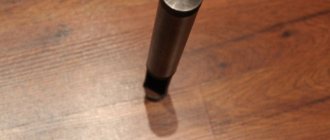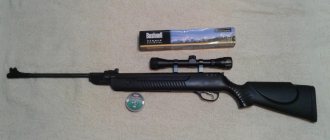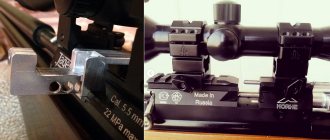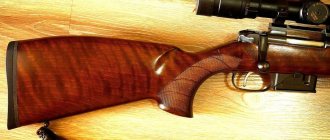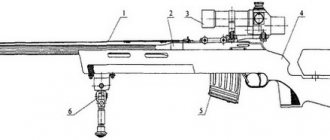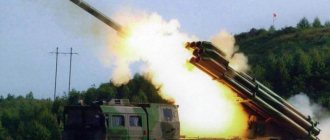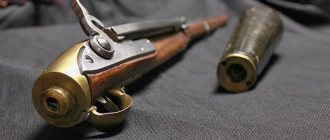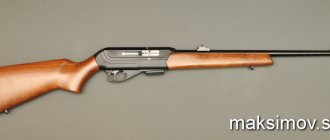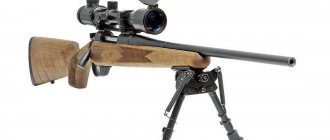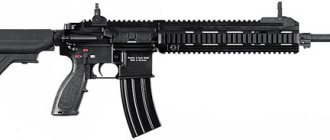The single-shot small-caliber rifle TOZ-8 was released as a sporting weapon chambered for a 5.6 mm rimfire cartridge. Although the small-caliber carbine was successfully used in sports shooting, professional hunters also appreciated it, because a 5.6 mm caliber bullet caused minimal damage to the valuable furry skin of the animal.
The development of shooting sports in the USSR is associated with the appearance of the small TOZ-8. DOSAAF veterans still speak warmly of this trouble-free single-shot rifle. Many Soviet shooting champions trained with this simple and reliable weapon.
Disassembly
To clean and lubricate the weapon, it is necessary to periodically carry out partial disassembly.
A complete repair is carried out if necessary to repair the rifle. Disassembly is simple - this is one of the advantages of the carbine.
- By pressing the latch, the magazine assembly is removed.
- Holding the plug and pushing it slightly forward, remove the box lock.
- Retract the bolt and remove the firing pin spring and both return mechanisms.
- The reloading handle is turned 90 degrees and removed. Then take out the bolt and firing pin. In this form, the weapon is ready for lubrication and cleaning. It is recommended to carry out the procedure every 150 shots. During storage, the carabiner must be lubricated once every 3 months.
- If complete disassembly is required, then after the above steps you need to unscrew the screws at the bottom and disconnect the stock from the barrel with the box.
Assembly is performed in reverse order.
Sources
- https://znaivse.biz/obrazovanie/melkashka-06-10-2018.html
- https://www.dyplet.com/oruzhiyeoxoty/toz-99.html
- https://www.ohotniki.ru/weapon/smoothbore/article/2018/10/05/652308-poluavtomat-mts-2112-rodom-iz-sssr.html
- https://WarWays.ru/ognestrelnoe-oruzhie/vintovki-ruzhya-karabiny/toz-99.html
- https://podpricelom.com/ognesrelnoe-oruzhie/nareznoe/toz-99.html
Hunting rules
If there has been no precipitation for about a week, then you can simply wipe the small pieces with an oily cloth. When water gets on the gun, you need to immediately wipe and lubricate it, not forgetting about the bolt. During the winter hunting period, the gun is usually rarely brought into the heat.
Hunting with such a gun is mainly carried out when trapping fur-bearing animals, so you definitely won’t miss them. When hunting birds, you should use a scope with 4x magnification. This approach will ensure accurate visibility of birds in the evening and early twilight.
The shot is fired only at the base of the neck, since if you shoot in the chest, the bird will fly away and die. It is good to hunt birds before winter, since they often fly onto roads and river areas in order to fill their stomachs with small stones.
Calibers
By small guns, hunters usually mean guns with a caliber of 5.6 mm; in Russia they also include models with calibers of 6.5 mm and sometimes 7.2 mm.
The most common type of cartridge is .22LR (Long Riffle), this is one of the varieties of 5.6 mm caliber, rimfire ammunition. Austrian and German manufacturers designate it slightly differently - .22lfB. The length of such a cartridge is 24.77 mm, and the length of the sleeve is 15.1 mm. A small gun for hunting is, in most cases, a rifle designed to shoot .22LR. Together with a high-quality weapon, such a cartridge provides high accuracy and accuracy of fire, for which amateur hunters, professionals and athletes love it.
general characteristics
The TOZ 8 small-caliber sports rifle for sporting purposes was manufactured according to the design of D.M. Kochetova. The scope of TOZ 8 is training shooters, training athletes, mass competitions at shooting ranges or shooting ranges. This single-shot sporting rifle is one of the mass-produced models.
Toz 8, 22 caliber (5.6)
The 5.6 mm TOZ-8 is based on a conventional striker-type trigger mechanism. The rifle is equipped with a thick and heavy barrel. The sliding bolt is locked by turning the bolt stem.
The TOZ-8 small-caliber shotgun does not have a safety lock, the stock is made of birch, the fore-end is thickened, and the neck of the butt is pistol-shaped.
Review of popular hunting models
Today there is a fairly large selection of modern hunting rifles classified as small-caliber.
However, most Russian hunters prefer small-caliber TOZ rifles.
- TOZ-8. A rifle that has been produced in Tula since 1932. It is this rifle that allows you to hit a squirrel “in the eye.” The accuracy of this rifle is already legendary. But, in addition, TOZ-8 is perfect for teaching the basics of shooting, both for hunters and athletes.
- TOZ-16 and TOZ-17, impeccable bestsellers among amateur hunters. These two rifles became the basis for the creation of small-caliber carbines, such as TOZ-78, TOZ-78-04M and TOZ-78-01M.
- Carbine "Sable". This carbine is based on the Biathlon rifle. Equipped with a magazine (5-10 rounds). May have optics.
Design of TOZ-8
Rifle barrel
The barrel bore has four screw grooves, each with two turns. The length of the rifling stroke is 35 centimeters. The rifle number and year of manufacture can be found on the sighting block, which is located on the Toz-8 barrel.
The base of the front sight is installed in a longitudinal groove on the front of the barrel. There are two longitudinal grooves on the back of the barrel; they are made for an aiming block. There is also a special stump at the back, to which the receiver is attached using a pin. The barrel and stock are secured with a screw, which is screwed into a transverse groove on the front of the receiver.
Rifle receiver
The bolt and liner are placed in the receiver. The box acts as a base for the firing mechanism. It is made in the form of a simple pipe that looks like an extension of the trunk. The receiver is attached to the stock with a tail screw, which is screwed into the rear part (into the “tail”).
There is a window on the outside that is used for inserting cartridges and ejecting cartridges.
It is located in the receiver and secured with a trigger spring. Created for:
Directions of the cartridge into the chamber when loading; Reflections of cartridges during ejection after a shot; Shutter directions when moving forward.
Trigger mechanism
The design of the trigger includes: a trigger, a trigger spring with a stand, a screw and an axis. When the trigger is released from cocking, the spring strut is recessed by the trigger. The trigger is connected by a spring using an axis. The spring is retracted down due to two protrusions on the hook. There is a limit to the movement of the tail, which is provided by a protrusion on the front of the trigger.
The trigger spring ensures that the trigger is cocked and limits the rearward movement of the bolt. It is attached to the receiver with a screw. There is a hole at the rear end through which the axle passes for attachment to the trigger. There are two cuts at the top of the spring: the first is for fixing the hammer in cocking, the second is for limiting the movement of the bolt back.
The trigger guard is attached to the forend with two screws. The trigger passes through a metal spacer with holes under the heels. The hole restricts rearward movement of the trigger.
The sighting mechanism consists of:
Aiming block. Used to fix the pin and strengthen the sighting bar spring; Sighting bar. Equipped with a mane with a slot used for aiming. The sighting mechanism can be adjusted for shooting at various distances - from 25 to 250 meters. The side edges of the strip are equipped with cutouts for attaching a clamp; Clamp; Sighting bar spring. Fixes the bar in the required position; Front sight.
Gate
The bolt sends the cartridge into the chamber, closes the bore, ejects the cartridge case of the spent charge and is an important element in firing shots. Comprises:
Combat larva. It is the connecting link of all elements of the shutter. On the right and left there are two grooves for the ejector and sleeve deflector. The larva is equipped with a special cup for placing the ammunition cap. The ejector and reflector sleeve axes are placed in vertical holes. The rammer is located below. The movement of the shutter is limited by a ledge on the rear lower part of the combat cylinder. The stem of the bolt is placed on the stump of the combat larva. Inside it there is a channel for the drummer; Ejector. Ejects cartridges from the chamber and receiver using a reflector; Sleeve reflector. Fixes the cartridge in the calyx of the larva; Bolt. Equipped with a hole through which a pin passes to secure the firing pin with the coupling and the combat cylinder. There are two small and two large cutouts. The large ones are used to pull the trigger back, the small ones to limit the rotation of the stem.
The design of the impact mechanism includes:
Trigger. Designed to install a firing pin on a combat platoon. Attached to the firing pin with threaded holes and a pin; Drummer; Action spring; Clutch. Connects the striker to the combat cylinder; Lodge. Connects all parts of the carbine and is responsible for the ease of use of the Toz-8.
Commercial small-caliber rifles
Commercial single-shot rifles of 5.6 mm caliber manufactured by domestic factories include the TOZ-11 and TOZ-16 rifles (Fig. 190).
Rice. 190. Small-caliber hunting rifle TOZ-16
They differ from sporting small-caliber rifles in their shorter length and lighter weight. The TOZ-11 and TOZ-16 rifles are characterized by the following design and ballistic data:
Carbines
Domestic military carbines of the 1938 and 1944 models .
Like a military rifle, they are rarely found in investigative practice and mostly in a modified form, that is, with a shortened barrel, a reduced butt, a removed sighting bar, a magazine box removed or cut flush, etc.
The carbines differ from the domestic rifle of the 1918/30 model. only lighter weight and shorter length, except for the absence of a bayonet on the 1938 model carbine and the presence of a permanently folding bayonet on the 1944 model carbine.
The basic design data for the carbines are the same as for the rifle of the 1891/30 model, with the exception of the following:
Note. Carabiner weight
Model 1944 is indicated with a bayonet weighing 0.4 kg.
The length of the carbine
(1020 mm) of the 1944 model is indicated with the bayonet folded down.
Ammo. For shooting from carbines of the 1938 and 1944 models, the same cartridges are used as for the 1891/30 model rifle.
Domestic hunting rifles
| Rice. 191.Hunting carbines: a -TOZ-17 (caliber 5.6); b -MC-18 (caliber 5.6, 7.62 and 9 mm) |
For the purposes of commercial and amateur hunting, domestic factories produce hunting single-barrel five-shot carbines MTs-18 chambered for standard cartridges of 5.6 mm, 7.62 mm, 9 mm calibers and commercial single-barrel five-shot small-caliber carbines TOZ-17 chambered for the caliber
5.6 mm (Fig. 191).
Smoothbore guns
General information. Smoothbore weapons are designed primarily for shooting shotguns. Sometimes special bullets are used to fire these weapons.
There are a large number of different types and models of smoothbore weapons, mainly sporting and hunting.
Modern smoothbore weapons are breech-loading: they are loaded from the breech with pre-loaded cartridges. Shotguns loaded through the muzzle are almost never seen nowadays.
Based on the design of the percussion mechanism (lock), they distinguish between guns (with an external trigger); hammerless shotguns (with an internal trigger); guns with cylindrical striker bolts.
To characterize the type and model of a weapon, in addition, the following main features are used: number of barrels; location of trunks; type of drilling of trunks; caliber; number of charges and recharging method.
In terms of the number of barrels, the most common are single-barreled and double-barreled guns, three-barreled or tee-barrels—shotguns are extremely rare.
Based on the location of the barrels, a distinction is made between double-barreled shotguns with horizontally paired barrels and double-barreled shotguns with vertically paired barrels.
The main characteristic feature of shotgun barrels is the absence of rifling on the inner surface of the bore. There is, however, a special type of barrel, most of which is smooth, and only at the end, at a certain distance from the muzzle, there are rifling. These trunks are called paradox.
According to the type of drilling, cylindrical trunks with a diameter of one are distinguished. analogue along the entire length of the barrel (not counting the chamber and transition cone), cylindrical with pressure, the diameter of the channel gradually decreases towards the muzzle (by 0.1-0.25 mm) and check. The latter are characterized by the fact that the diameter of the bore at the end of it, near the muzzle, is smaller than in the rest. The reduction in choke diameter compared to the rest of the barrel bore for various types of shotguns ranges from 0.25 to 1.3 mm. In accordance with this, a distinction is made between half choke, medium choke, full choke and very strong choke (with a narrowing of more than 1 mm). In Paradox barrels, the rifling is located in the choke area.
The diameter of the bore is called caliber. With regard to the designation of the caliber of smoothbore guns, an outdated system has been preserved, which now has only a conditional meaning. The caliber of this system is determined by the number of round bullets corresponding to the diameter of the bore that can be made from one pound of lead. Currently, these caliber designations are translated into diameters of barrel bores and chambers and are expressed in mm.
To avoid errors when determining the calibers of guns with different types of drilling. For barrel dexterity, it is advisable to determine the caliber size by the diameter of the chamber.
Depending on the number of charges, smoothbore guns can be single-shot or multi-shot.
According to the reloading method, in the majority of cases, smooth-bore weapons are non-self-loading. Repeating rifles are more common. Only as an exception are there some models of automatic multi-shot smoothbore weapons.
Below is a brief description of some typical models of domestically produced smooth-bore weapons.
Rice. 192. Single-barreled shotguns of the Kazansky system:
a - trigger (ZK model); b - hammerless (model 3KB) - 1 - shutter control key (lever); 2—trigger: 3'—cock
Rice. 193. Single-barrel hammer-fired shotgun of the Kazansky system in the open state:
I - trunk; 2 — chamber; 3 - extractor; 4 - trigger; 5 — neck of the stock; 6 — shutter key (lever); 7 •— trigger; 8 — trigger guard; 9 — under-barrel hook (beard); 10 - block; 11 - axial bolt; 12 — fore-end; 13 — forearm recess
Rice. 194. Barrel of a shotgun of the Kazan system:
1 - front sight; 2 — barrel swivel; 3 — hook for securing the fore-end; 4 — underbarrel hook (beard)
Single-barreled shotguns
Gun designed by Frolov. Frolov's gun or (“frolovka”) refers to the type of “unbreakable” guns, or guns with fixed barrels.
"Frolovka" is a converted 7.62 mm combat rifle of the 1891 model. Design changes affected mainly the barrel (reaming) and stock (shortening). The rifle bolt, a type of sliding bolt with rotation when locked, was left unchanged.
Our industry produced several versions of the Frolovka: without a magazine (single-shot) and with a magazine for two (28 caliber) or three (32 caliber) cartridges. The barrel drilling is cylindrical. The length of the chamber for a metal sleeve is 70 mm.
“Frolovkas” were manufactured in the following calibers: 20, 24, 28 and 32.
Rice. 195. The bolt of a shotgun single-barrel trigger gun of the Kazan system (ZK):
1—barrel: 2—chamber; 3—axis of the shutter key (lever): 4—striker: 5—fixed stop of the shutter spring; 6—shutter key (lever): 7—shutter spring; 8—the bolt hook, which fits into the recess of the under-barrel hook; 9—under-barrel hook (beard); 10-axis bolt •
Rice. 196. Impact and trigger mechanism of a shotgun single-barrel trigger gun of the Kazan system (ZK)
1—trunk; 2—chamber; 3—striker spring: 4—striker; 5—knitting needle 6—pusher; 7—trigger spring; 8—trigger: 9—combat cock; 10—cock safety cock: 11—hammer axis; 12—trigger guard: 13—barrel hook, under-barrel hook (beard); 14-axis bolt
Berdan gun. Sometimes you can find smoothbore guns converted from old-style Berdan-type combat rifles, which were in service before the army was equipped with a rifle of the 1891 model. The bolt is a rifle-type, sliding type with a turn when locked. Smooth-bore Berdan guns were manufactured by our factories with barrels of 16, 20 and 24 calibers. “Berdanka”, just like “Frolovka”, is a type of shotgun with fixed barrels.
Guns designed by Kazansky (Fig. 192-196). Single-barreled shotguns designed by Kazansky are found in two versions - hammer-fired (ZK) and hammerless (3KB).
Both options are similar, except for the lock design (impact mechanism). Caliber - from 12 to 32. Drilling of the barrel - cylindrical with pressure. The chamber is for a paper or metal sleeve.
The guns are of the “breaking” type, that is, with a movable barrel. The spring-type shutter is controlled by a key. The spent cartridge case is removed (partially) from the chamber using an extractor when “breaking” the gun. In order to open (“break”) the gun, you need to press the bolt key (lever) to
neck of the stock.
In hammerless models “3KB”, the hidden hammer is cocked when opening (“breaking”) the gun, that is, when pressing the handle of the bolt key (lever).
Shotguns model IZH-5. Single-barreled trigger guns IZH-5 are found in various calibers from 16 to 32.
The bore drilling is cylindrical; 16-gauge shotguns have a cylindrical barrel with a pressure of 0.1 mm.
The chamber is for a paper sleeve (16 and 20 gauge) and a metal sleeve (16, 20, 24, 28 and 32 gauge).
The shotguns are of the "break-in" type. The shutter is controlled by an upper key (lever) mounted on the top of the block. The impact system consists of a trigger rotating on an axis and an inert firing pin, similar in general terms to the impact system of the gun model - “ZK”.
Double-barreled shotguns
Trigger gun - model “B” (Fig. 197, 198). The caliber of model B shotguns is 16 and '20. The length of the barrels is 72 cm, the weight of the gun is 3.094 kg. Mass-produced shotguns have barrels drilled: the right barrel is a cylinder or a pressure cylinder, the left is a choke.
The chamber is for a paper sleeve; chamber length - 70 mm.
To load and unload the gun, you need to move the top key to the right as far as it will go and lightly press the barrels and butt to “break” the gun.
Rice. 197. Double-barreled hammer-fired shotgun, model “B”
Rice. 198. Double-barreled trigger shotgun model “B” in open
position:
1 - left barrel; 2— sighting (upper) bar; 3 - small hook; 4 - extractor; 5 — groove for a small hook; 6 — block; 7— right trigger; 8 — left lock; 9 — board connecting screw; 10 — shutter lever (key); 11—box; 12 — left trigger (trigger); 13 — right trigger (trigger); 14 — trigger guard; 15 -^ left firing pin; 16—brant tube; 17 — transverse bolt; 18 — under-barrel hook; 19—axial bolt and 20—fore-end
The spent cartridge case or cartridge is removed from the chamber using an extractor when the gun is “broken.”
The triggers are returnable, that is, after hitting the firing pin, the trigger rebounds and is put on safety cock.
The firing pins are inert, that is, after hitting them with the triggers, they bounce off the primers under the action of their return springs.
Impact mechanisms are mounted on the inner sides of the locking boards. Hammerless gun model “A” (Fig. 199). The caliber of the gun is 16, weight is 3.3 kg. From-
Rice. 199. Double-barreled hammerless shotgun, model “A”
belongs to the “breaking” type. The bolt design and control are similar to the Model B gun. The drilling of the trunks is different for different specimens.
The chamber is for a paper sleeve. The triggers are located inside the so-called block and have strikers that directly strike the cartridge primer. When “breaking” the gun, the forend presses on the cockers, which, turning, cock the hammers. The gun is equipped with a safety lock that locks the trigger mechanism.
The fuse control button is mounted on the shank of the block.
Hammerless shotguns IZHB-46, IZHB-47. The IZHB-46 shotgun (Fig. 200) has a -16 caliber. The total weight of the gun is 3.2 kg. It belongs to the “breakable” type. Sverlovka
Rice. 200. Double-barreled hammerless shotgun IZHB-46: 1 — bolt key; 2 - safety button
barrels: on the right - a cylinder with pressure, on the left - a choke. The chamber is for a paper sleeve.
The bolt mechanism is standard; the bolt key is located on top of the stock neck.
The triggers are cocked when the gun is “broken.” The gun is equipped with a safety device that locks the triggers. The safety button is placed next to the bolt key.
The IZHB-47 shotgun differs from the one described above in the drilling of the barrels (the right one is half-choke, the left one is choke), as well as the finishing of the external parts.
Combination shotguns
Combined hunting rifles or bullet-shot doubles (one barrel is smooth, the other is rifled), tees (two barrels are smooth, one is rifled and vice versa), four-barreled guns (two barrels are smooth, two are rifled, and other combinations) are intended for shooting with standard hunting bullets and shot.
Domestic factories for the purposes of amateur and commercial hunting mainly produce doubles with vertically paired barrels. The upper barrel has a smooth channel and is intended for shooting shotguns. The lower one is rifled and is intended for firing bullets. The most common models of these guns include IZH-56-1. IZH-56-3 and MC-5.
Combination shotguns include a single-barrel hammer-fired shotgun model IZH-K-4, equipped with a 5.6-mm barrel insert. The presence of rifling in the barrel insert allows firing small-caliber bullets from side-fire cartridges. When the barrel is removed from the gun, shooting is carried out with standard 16-gauge shotgun cartridges.
Marking (branding) of smooth-bore weapons is carried out by applying distinctive signs (letters, numbers, special symbols, brands) applied mechanically to barrels, under-barrel hooks, barrel platforms (cushions), pads, stocks and other parts of the weapon (Fig. 201).
Rice. 201. Brands of domestic factories and guns
Identification marks include the serial number of the gun, the brand of the gun or gun, the caliber, the diameter and the length of the chamber.
There are also signs indicating the type of drilling of the barrel, the number of the check narrowing, and the permissible pressure in the chamber; test mark for strength, accuracy and accuracy; stamp of quality control department and acceptance inspector.
When firing from the rifled barrels of IZH-56 shotguns and the insert-barrel folded into the IZHK-4 shotgun, 5.6 mm side-fire cartridges are used.
In 8 MTs-5 shotguns, rifled barrels are manufactured not only for 5.6 mm side-fire cartridges, but also for central fire cartridges with calibers of 7.62 mm,
9 mm and 12.7 mm.
In forensic terms, markings play a significant role, especially when identifying and examining weapons of foreign origin.
Of greatest interest when determining the origin of a weapon are the test marks associated with preliminary tests of barrels for strength and the final test of the finished gun by shooting (Fig. 202).
Airguns
Investigative practice knows cases of severe bodily injuries caused by the criminal use of pneumatic weapons or careless handling of them.
Bullets fired from modern sporting air pistols and rifles have significant penetrating power in the immediate vicinity of the muzzle of the weapon. Penetration ability, as is known, depends on the value of the initial kinetic energy of a moving bullet or, in other words, on its muzzle energy. The muzzle energy of a bullet weighing 0.5 g, fired from a domestic sports air rifle with an initial speed of 140-170 m/sec, reaches a noticeable value of 0.49-0.74 kgm.
In domestic models of air pistols and rifles intended for sport shooting, the bullet is ejected from the barrel by compressed air.
The air is compressed in the air cylinder by a piston that moves quickly (from the rearmost to the frontmost position) under the action of a pre-compressed coil spring. The spring is compressed at the moment of loading (“breaking”) the weapon. The compressed spring is released before firing by pressing the trigger.
Air pistols and rifles manufactured by domestic factories have a caliber of 4.5 mm and are intended for initial shooter training, marksmanship training, and also for target shooting.
Rice. 202. Test marks of hunting rifles from various countries:
1 - USSR; 2 - England: 3 - Austria; 4 - Belgium; 5 - Hungary; 6 - Germany; 7—Spain; 8 - France and 9 - Czechoslovakia
Air guns (Fig. 203)
Pneumatic pistol of the domestic model, produced in 1946. Caliber - 4.5 mm; gun weight - 0.8 kg; gun length - 280 mm; barrel length - 125 mm - number of right-hand rifling - 12; rifling pitch - 350 mm; rifling angle - 2°20′; mainspring tension: preload—14 kg; working tension - 28 kg; the force applied to the trigger is from 1.5 to 2.5 kg. The 1946 model air pistol was also produced with a smooth bore. The ballistic data of a smoothbore pistol are as follows: the maximum flight range of a bullet with feathers at an elevation angle of 40°—45°—60 m; penetration depth into a pine board when shooting at 10 m: for a lead bullet - 2-3 mm; for a bullet with feathering (tassel) - 7-8 mm.
| Rice. 203. Domestic air pistol |
Air rifles (Fig. 204)
Domestic air rifle (old model). Caliber - 4.5 mm; rifle weight - 2.15-2.25 kg; rifle length - 985-1035 mm; barrel length—400–450 mm; mainspring tension - 58-66 kg; average pressure in the air chamber is 5 atmospheres; number of rifling in the barrel - 12; initial bullet speed - 144 m/sec; bullet flight range - 100-135 m.
Air rifle of the domestic model produced in 1955 (PSRM-2-55). The PSRM-2-55 air rifle is an improved model of the previous rifle.
Caliber - 4.5 mm; weight - no more than 2.25 kg; rifle length - 1035 mm; barrel length - 450 mm; the number of rifling in the barrel is 12; direction of rifling - right; rifling pitch—350 mm; rifling angle—2°20′; tension of the fighting rod
Rice. 204. Domestic air rifles
A - old model; B - model produced in 1955
gins: preliminary compression - 29.1 kg; working load - 56.3 kg; the force applied to the trigger is from 1.5 to 3 kg.
Airgun bullets
For shooting from domestic air pistols, etc. For rifles of 4-5 mm caliber, three types of bullets are used: expansion bullets (“Diablo”), tailed bullets (tassels) and ball bullets (pellets) (Fig. 205). ^^
Rice. 205. Pneumatic weapon bullets: 1 2 and 3 - expansion (“Diablo”); 4-with feathering (tassel) and 5-ball (pellet) Diablo bullets have a length of 4.7 mm; head diameter -
Ball bullets (pellets) have a diameter of 4.5-4.6 mm and a weight of 0.5-0.6 g.
Bullets with tail fins are steel cups, ending with a point on one side and a bunch (tassel) of pressed wool or viscose fibers on the other. Cup length
5-6 mm; brush length 10-12 mm.
Chapter 2
Getting permission
In fact, obtaining a permit for small-caliber weapons for hunting is no different from the procedure for obtaining rifled weapons.
To obtain permission for small-caliber rifles, you must provide the following documents to the LRO:
- Hunter's ticket.
- Conclusion of a specialized medical commission.
- A report-conclusion from the local inspector, which contains information about the conditions for storing weapons in the house of the applicant for small-caliber weapons for hunting.
It should also be remembered that a permit for a rifled weapon can only be obtained if you have five years of experience in owning a smooth-bore weapon.
Smoothbore weapons
The ideal option for novice hunters would be a double-barreled shotgun. It, just like a carbine and rifle, can be small-caliber. Most often, 410 caliber cartridges are used for hunting small game with a double-barreled shotgun.
In addition, double-barreled shotguns differ in the types and arrangement of barrels. There are striker-fired, hammer-fired, and vertical or horizontal models. Experts recommend “verticals” to beginners. They have better visibility than the horizontal ones, and the cartridge ejection mechanism is more reliable.
General information about TOZ-8
The gun was developed by engineer D.M. Kochetov. Its design includes a typical rimfire trigger, designed for charges of 5.16x16 millimeters. The long service life of the rifle was ensured by a thick cylindrical barrel. Its length is 640 millimeters.
Specifications:
For shooting, 5.6 mm caliber cartridges are used; The rifle barrel length is 640 millimeters; The overall length of the rifle is 1110 millimeters; The weight of the unloaded rifle is 3.2 kilograms.
The clutch is installed on the front of the valve, where the diameter narrows. When the shutter is turned, the clutch turns. The Toz-8 stock is made from high-quality birch. For convenience, it is made of a pistol type and has a thickened fore-end.
Toz-8M
This small-caliber weapon is a modified version. Used for sport shooting and small game hunting. The main differences in design are the sighting mechanism. Here it is made of a sector type, which increases shooting efficiency.
Thanks to this device, the shooter can quickly adjust the sight height. The front sight has an additional ring earpiece. The bolt has a smaller diameter and lacks a clutch: this makes reloading more convenient and does not allow gases to escape back. The stock of the Toz-8 sports version received a wider fore-end.
The best small bore rifles for hunting
Today there is a huge selection of small things on the market; choosing the right model is quite difficult. The main thing is to understand for what purposes the weapon will be used. Let's introduce some of the most popular manufacturers of small-caliber shotguns.
SABATTI
This is an Italian manufacturer, the products have reliable components made from chromium-molybdenum. The wooden parts are made of walnut. The guns have good shot accuracy over long distances. Good build quality extends the life of the weapon.
"IZHMASH"
The Izhevsk plant is famous for its small-caliber rifles among biathlon fans and hunting enthusiasts.
Models of the Kalashnikov concern are reliable and unpretentious.
The weapon can be used in extreme temperatures and high humidity. The most famous model of this, a semi-automatic gun, popular since the times of the Soviet Union. Any scope fits the rifle.
VPO "MOLOT"
The Russian company produces rifles that are characterized by their simplicity of design. Their mechanisms are resistant to stress. The plant produces weapons with a 5.6 mm caliber, these are small ones of the Vepr brand.
HATSAN rifles
The Turkish manufacturer confidently holds the brand. HATSAN produces a series of small-caliber rifles. A number of modifications have a wooden and plastic stock; cheekpieces and butt pads can be adjusted. The weapon is not heavy (weighs up to 3 kilograms), the rifles are budget.
FRANCHI rifles
Shotguns from the Italian company are simple and reliable to maintain. The barrel is made of steel using cold forging. The weapon shoots accurately and weighs little. Can be used in difficult climatic conditions.
Tula Arms Factory
The most famous of the domestic small animals, they are used in training, for sports shooting ranges, and for hunting small animals and birds.
The most popular domestic rifles, they are used in training, sports shooting and in hunting small animals or birds. Many hunters say that the TOZ 78 sample is the best small-caliber rifle for hunting. It works in any area and maintains temperatures of different amplitudes. In addition, it has a good range, is reliable and easy to use. Suitable for beginners and pros.
Anschutz 1416
The rifle is from a German creator and has excellent shooting accuracy.
Zastava mp22
Weapons from Serbia, made of wood and steel, without the use of plastic. Characterized by a sliding butterfly valve.
How does TOZ-99 differ from other carbines?
Contents of the article:
- How does TOZ-99 differ from other carbines?1
- Characteristics of a self-loading carbine2
- Known modifications3
- Advantages of a self-loading carbine4
- Disadvantages of the carbine5
- Conclusions6
This rifled weapon has a number of basic elements that are found in the well-known model of the TOZ-78 carbine. To be blunt, by all appearances this rifle resembles him in many ways.
There are only a few improvements and small changes that give the weapon a touch of modernity.
The most important difference should be considered the shutter operating system. In the new model, the shutter moves automatically, while in the old model it can only be moved manually.
To put it simply, the carbine is self-loading and this is its uniqueness, which makes it easier to shoot while hunting.
Self-loading smoothbore weapon
A good half of this segment is occupied by pump-action weapons. Unlike the smoothbore shotguns described above, here we have a magazine into which 5-7 cartridges are supplied. In this case, reloading is not needed, so the rate of fire for pump-action weapons is noticeably higher than for conventional double-barreled guns.
But this type of weapon also has a number of disadvantages. The first is weight. Pump-action shotguns are clearly heavier than double-barreled shotguns, and during hunting, especially in winter, every gram feels like a kilogram. The second is a complex mechanism that is less reliable under the same field conditions and can fail if it gets into the mud. Well, the last minus is the short distance to hit the target. Therefore, you cannot sit in an ambush and with optics with such a gun.
Well, the cost of self-loading models is much higher than that of other smooth-bore weapons. In addition, domestic manufacturers concentrate specifically on the double-barrel segment, because this is their main source of income (in the civilian sector).
What kind of game should you hunt with small fish?
Hunting with small-bore weapons requires a very critical attitude to the choice of type and size of game. If you are not sure that a small-bore cartridge is best suited for the bird or animal you are used to hunting, buying a small-caliber cartridge most likely does not make sense. Who can you hunt with such a weapon?
Feathered game
Good results can be achieved when hunting black grouse and wood grouse, duck and goose.
A small gun is not a shotgun, and it’s difficult to hit game on the fly with a bullet. However, you can also find special small-caliber cartridges on sale, in which capsules with shot are used instead of bullets.
Small fur-bearing animal
Hunting for fur-bearing animals with small arms is one of the main areas of application of small-caliber weapons. With such guns you can shoot squirrel, weasel, arctic fox, sable, mink, marten, ermine, weasel.
Medium sized beast
From small rifles you can also shoot small or medium-sized animals - from rabbits to roe deer. This also includes the hare, fox, beaver, and wolf.
Hunting with small animals for a larger animal is impractical; in this case, a large number of wounded animals remain, and the animals that are still caught are subjected to unjustified suffering.
You also need to keep in mind that the small thing is not suitable for everyone:
- the first thing you should do is find out whether it is possible to hunt with a small gun in your country and in your region, what kind of animal and at what time hunting with such a weapon is allowed;
- shooters who are not accurate enough when hunting with small animals are left with a lot of wounded animals;
- small guns can be dangerous, especially if we are talking about a rifle, since a bullet from it flies further than a kilometer;
- Taking advantage of the range of a small-caliber rifle, some shoot animals and birds at very long distances; in such a situation, the game feels completely safe. These shooters often do not follow the rules, turning the hunt into recreational shooting at targets, and leaving a lot of wounded animals - this should not be done.
Scope of application
Domestic consumers use small-caliber rifles mainly for hunting and prefer them to other types of weapons due to the high reliability and availability of ammunition. The little thing is a practical purchase: moderately versatile, easy to maintain and also inexpensive.
In European countries, rifles of this caliber are considered weak, because hunting small fur-bearing animals is not so common there. For example, hunting squirrels in Russia is a common and commonplace phenomenon, while in Europe it is recognized as an ornamental park animal and is prohibited from being hunted. Abroad, small-caliber rifles are used mainly for recreational and sport shooting.
Varieties of small things
Small-caliber shotguns can be either smooth-bore or rifled. Which small fish to choose depends on your hunting goals and hunting experience. Most often, when talking about small caliber, they mean rifled weapons. However, smoothbore guns also have their uses. Their main disadvantages are lower killing power, shorter range and accuracy of the shot; accordingly, their use is justified when hunting small animals or birds at close ranges.
The main types of designs of small things:
- breaking multi-barreled guns;
- bolt-action or bolt-action rifles;
- semi-automatic devices.
There is no clear answer to the question of which one is better for hunting - it depends on your goals and personal preferences.
Breaking guns
The break-even double-barreled shotgun is the classic option that most hunters start with. A smoothbore double-barreled shotgun is a good option for those who are just starting to learn the basics, but many experienced shooters also choose this weapon. Mounting of trunks can be vertical or horizontal. The first option is preferable, as it has better shooting accuracy.
Bolt rifles
The bolt-action rifle is a simple and reliable option for a small-caliber rifle. The design features of such weapons are that since a low-power cartridge is used, instead of special combat stops for locking, stops on the reloading handle stem are used. Also, small-caliber shotguns are usually equipped with a simplified bolt action.
Another advantage of them, in addition to simplicity and reliability, is their low price compared to semi-automatic machines. When using bolt guns, removal of the spent cartridge and reloading are done manually, as a result, the rate of fire is slightly lower than when using semi-automatic shotguns. Also, when reloading, it is necessary to remove your hand from the trigger, as a result the sight becomes confused.
Small caliber weapons
People call a small-caliber rifle a “small rifle.” Such weapons primarily found their application in the fishing sector. With a small rifle they go after a small animal: a bird, a hare, a squirrel, a fox, etc. Small-caliber rifles are ideal for such hunting, and they have been used for more than a dozen years.
Some people mistakenly believe that you first need to choose a weapon, and then select a cartridge for it. But experts in this field convince us otherwise. The critical point in this case is the cartridge, and not the rifle itself. So you need to decide first with him, and only then with the weapon.
Operating principle of TOZ-99
The TOZ-99 self-loading carbine uses the energy of powder gases for reloading. The weapon barrel is locked by the combined action of two springs. When the barrel is unlocked, the spent cartridge case is removed, while the mainspring is cocked, and the firing pin is also cocked.
The design includes a fuse. It blocks the sear, and the striker cannot be de-cocked. For the convenience of the user, when the safety is set to the “fire” position, a red dot is visible on the body of the trigger mechanism. If the fuse is set to the “safety” position, the red dot disappears.
Like any hunting weapon, TOZ-99 must be stored in a special safe. Before storing the gun, it must be cleaned, lubricated and unloaded. Ammunition for rifled weapons should be stored separately, or, as a last resort, in a separate, locked cell of a gun safe.
Tips for choosing
All hunting weapons, including small-caliber ones, can be divided into two types: smooth-bore and rifled. The latter allows the use of cartridges with greater destructive power, while the former is limited to the use of exclusively hunting ammunition. Depending on the type of fishing, the appropriate species is selected.
It is also worth noting that Russian legislation provides for restrictions on access to rifled weapons. It can only be obtained after five years of using smooth-bore models, and the experience must be continuous.
Characteristics of a self-loading carbine
- The weapon can fire 5.6 mm rimfire cartridges. According to the manufacturer's recommendation, it is better to use sporting and hunting cartridges.
- The barrel is made of high quality steel with a chrome-plated chamber and bore, which only adds value to the weapon. The length is 536 mm.
- The front sight is adjustable vertically and horizontally, and the rear sight is drum-type with several divisions. In addition, there are special grooves for attaching an optical sight.
- The carbine has a safety feature in its design, which is turned off or on using a flag located in front of the trigger.
- For continuous firing of several shots, a magazine for five or ten rounds is provided.
- The bolt moves due to the action of the energy of the powder gases. He ejects the spent cartridge case, cocks the mainspring, sends a new cartridge case into the chamber and installs the firing pin.
- The stock is made in most cases from birch and walnut, but beech is used much less frequently. Some models are made with a cheek.
- The hook release cannot be adjusted as there are no adjustment screws. The pressing force ranges from 2 to 3 kg.
- The weight of the carbine reaches 2.4 kg, which can be considered light weight.
Features of use
Small-bore rifles have excellent performance compared to pump-action and even double-barreled shotguns. Small-caliber weapons have noticeably less recoil at the moment of firing, and this despite their low weight (about 3 kg).
In addition, small-caliber rifles have good accuracy, and if they also have high-quality cartridges, the destruction range increases noticeably. It is also worth noting that such weapons do not require maintenance and are unpretentious to climatic conditions. And cartridges for small-caliber rifles are cheaper than for shotguns.
For novice hunters, smooth-bore small guns will be an excellent aid in training. Here you can, without sparing ammunition, shoot at paper targets and cans, and then move on to game birds or small animals. A shot from a small-caliber rifle is much quieter and does not disturb the inhabitants of the forest, unlike more serious weapons that rumble throughout the entire area after each pull of the trigger.
But there are also disadvantages here. Unlike the same 12 gauge, more careful aiming is necessary, because the scatter of small shots is small, and it will not be possible to fire from the belt. You should also take into account the direction and speed of the wind for greater accuracy of the shot. In this regard, experts in this field strongly recommend equipping small-caliber rifles with optical sights, otherwise it will be much more difficult to hit the target.
Description of TOZ-99 and its main performance characteristics
The TOZ-99 carbine is a rather rare weapon, the existence of which many hunters do not even suspect. However, the Tula Arms Plant managed to produce several modifications of this carbine, one of which was the TOZ-99 Lux model. This modification has improved build quality and is free of all the shortcomings of the base model.
Shooting from the TOZ-99, as well as from the TOZ-78, is very comfortable, since the weapon has the following parameters:
- Light weight;
- Compact size;
- Good application.
As for the build quality of the TOZ-99, this small and light gun does not have any elegance of form at all. Taking it in your hands, you understand that this is a working weapon that will be appropriate in the taiga or as a working sporting rifle. The matching of wood to the metal parts of the weapon, the quality of the wood, the processing of the metal parts of the weapon - all this requires independent refinement. For the price they are asking for this carbine, the quality of workmanship should be much higher. However, for aesthetes there is the TOZ-99 Lux model, devoid of most of these shortcomings.
Number of trunks
You can also find shotguns with one and three barrels on sale. Experts strongly do not recommend the first option for novice hunters. The fact is that a single-barrel gun has only one shot, and there is no room for error. And since we are talking about small-caliber weapons, the fishery will focus on small, as well as shy animals. And he runs at the slightest rustle, not to mention the noise from a shot. With a double-barreled shotgun, your chances are twice as good.
As for guns with three or even four barrels, this is already something out of the exotic realm. Such options are suitable for hunters with extensive experience, because they are designed to perform specific hunting tasks. In addition to the fact that the visibility of such weapons is noticeably worse than that of the same vertical guns, the mechanisms, due to their complexity, require frequent attention and are less reliable, especially in the hands of beginners.
Disassembling the TOZ-8 rifle
It is carried out according to the following algorithm:
Receiver cap compartment. The finger of the left hand must be pressed on the trigger when the rifle is held by the neck of the stock with the left hand. After this, with your right hand you need to turn the shutter handle as far as possible to the left and up. The bolt is pulled back, easily hits the cap to move it from its place, after which it can be removed from the receiver; Removing the shutter. This happens by pressing the trigger (it’s more convenient to do this with the index finger of your left hand) and holding the handle. No effort is required, the shutter can be removed easily; Disassembling the shutter. A detailed algorithm with images should be included in the instructions with the gun; Removing the trigger. It is not recommended to do this yourself. It is better to entrust the trigger separation to a professional if it is necessary to replace the mainspring, firing pin or clutch; Removing the ejector and reflector sleeve. Use a small metal hammer to knock out the stud. After this, the ejector and sleeve ejector are easily removed from their places.
Complete disassembly
It is carried out according to the following algorithm:
Incomplete disassembly; Separation of the barrel from the stock. Having placed the Toz-8 small-caliber rifle with the barrel up, you need to firmly fix it with your left hand, after which you can unscrew the stop screw. Then the carabiner must be placed in a horizontal position and, holding it with your left hand, unscrew the tail screw. Having placed your finger in the receiver, you need to carefully lift it up and remove the barrel; Removing the trigger mechanism. The gun must be fixed in the “sight down” position, fix the receiver with your left hand, and unscrew the trigger spring screw. After this, it is easy to separate the trigger mechanism; Removing the liner. The carbine is fixed in the “sight up” position. Push the liner with a small stick, after which it will fly out of the receiver channel.
The gun is assembled in the reverse order (in cases with complete and incomplete disassembly).
Preparing to shoot
Many inexperienced hunters think that a newly purchased weapon can be immediately used for shooting. In fact, the rifle must first go through certain preparatory procedures, otherwise the accuracy of the hit will not be as great and its service life will be shortened. Here is a list of work that should be done first:
- Cleaning the barrel channel. Even if you purchased a weapon in a store (which is unlikely), all the goods there are immersed in a special preservative lubricant, which is not suitable for shooting. Used rifles may even have a lead coating. So before use, you need to thoroughly clean the barrel using a bronze brush.
- Getting rid of old oil or preservative grease. To ensure that no low-quality lubricant remains in the barrel, it should be removed using a rag soaked in kerosene. It is best to string the cloth onto the cleaning rod that comes with the rifle. Do not forget to thoroughly rinse the barrel after this to remove any remaining kerosene.
- Applying new lubricant. Once the bore has been cleaned and dried, it must be re-lubricated using a quality gun oil. It is applied using a rag and a cleaning rod or a special spray that is equipped with modern bottles.
Also, if desired, you can lubricate small mechanisms (shutter, trigger, etc.). It is necessary to repeat the cleaning procedure after each use of the weapon, since carbon deposits will appear on the barrel after the first shot.
